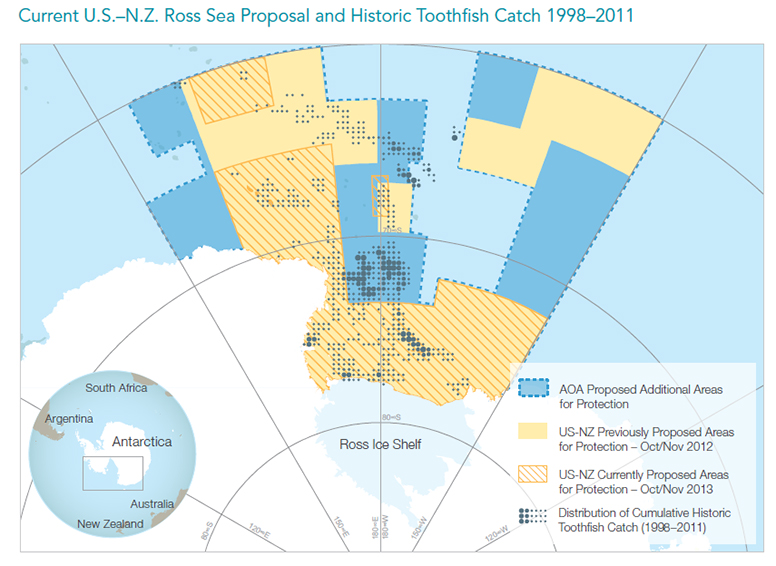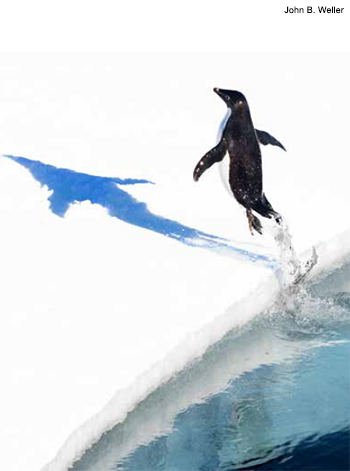The Case for a Marine Reserve in the Ross Sea
The Ross Sea is among the most hauntingly beautiful and species-rich marine environments in the world. Covering 3.6 million square kilometres (1.9 million square miles) in a horseshoe-shaped embayment clinging to the Antarctica coast south of New Zealand, the region supports species that have thrived essentially as they have for millennia. At the urging of scientists and conservation leaders, 24 countries and the European Union are expected to decide whether to create permanent protections for the Ross Sea or leave it vulnerable to large-scale industrial fishing.

Vital to species and science
A 2011 study published in the journal Biological Conservation called the Ross Sea “the least altered marine ecosystem on Earth,” with unusually large and closely interacting populations of several marine bird and mammal species. The study found that nine predators in the region—including emperor and Adélie penguins, minke whales, crabeater seals, and snow petrels—use the entire continental shelf and slope as a naturally choreographed behavioral opera that allows large populations of these species to coexist.

More than 500 scientists worldwide support the protection of the Ross Sea for its environmental and scientific value. The biodiversity in the region includes a significant percentage of the global distributions of:
- Adélie penguins (38%)
- emperor penguins (26%)
- Antarctic petrels (30%)
- Antarctic minke whales (6%)
- Weddell seals (45%)
- killer whales (50%)
In addition, the Ross Sea provides critical habitat for the Antarctic toothfish, a crucial predator in the region's food web. These fish are highly prized by the commercial fishing industry and marketed in the United States as “Chilean sea bass.” Commercial fishing is already disrupting the ecological balance in the Ross Sea. According to a 2012 study published in Aquatic Mammals, the average size of Antarctic toothfish in the sea is dropping. The Antarctic toothfish is harder to catch, the study added, and the numbers of its predator species are falling while counts of competing species are rising.
The Ross Sea also provides a vital global reference area for assessing and recording the consequences of climate change. It is one of the most pristine marine regions on Earth—and one that is frozen solid on the surface for much of the year.
Recommendations
 The near-term fate of the Ross Sea lies with the Commission for the Conservation of Antarctic Marine Living Resources, or CCAMLR, a 25-member body established in 1982 to sustainably use and conserve Antarctic marine life. The commission is considering two proposals: a marine-protected area in the Ross Sea and a representative network of marine protected areas adjacent to the East Antarctic coast.
The near-term fate of the Ross Sea lies with the Commission for the Conservation of Antarctic Marine Living Resources, or CCAMLR, a 25-member body established in 1982 to sustainably use and conserve Antarctic marine life. The commission is considering two proposals: a marine-protected area in the Ross Sea and a representative network of marine protected areas adjacent to the East Antarctic coast.
The Ross Sea proposal, sponsored by the United States and New Zealand, would create a large-scale marine reserve while allowing a limited Antarctic toothfish catch in a special research zone. In order for the protections in the proposal to be meaningful, the designation must be permanent, large-scale, and ecologically diverse.
The commission should establish a fully protected, permanent marine reserve in the Ross Sea as a first step toward a comprehensive system of reserves around Antarctica. This marine reserve should protect large-scale ecosystem processes in their entirety, including conserving: The biodiversity and ecological processes associated with the Ross Gyre, a massive area of rotating water formed by the Antarctic Circumpolar Current and the Antarctic continental shelf.
- The biodiversity and ecological processes associated with the Ross Gyre, a massive area of rotating water formed by the Antarctic Circumpolar Current and the Antarctic continental shelf.
- Areas critical to the life history stages of the Antarctic toothfish, the region's top fish predator. These include the species' feeding and spawning grounds.
- Critical geomorphic features including the seamounts, ridges, and troughs of the Pacific- Antarctic Ridge, and core foraging areas for land-based top predators.
- Biodiversity hot spots such as the Ross Sea continental shelf and slope, Balleny Islands, Pacific-Antarctic Ridge, and the Scott Seamounts.
- The Ross Sea as a critical climate reference area and climate refuge for ice-dependent species.
The Ross Sea designation must be permanent. The U.S.-New Zealand proposal includes review language that would allow management of the area to be adjusted if necessary, an approach supported by the International Union for Conservation of Nature. It also includes provisions to allow for scientific endeavors to collect data that underpin crucial research, including the impact of climate change.
Use the Download box above to view the complete fact sheet.






